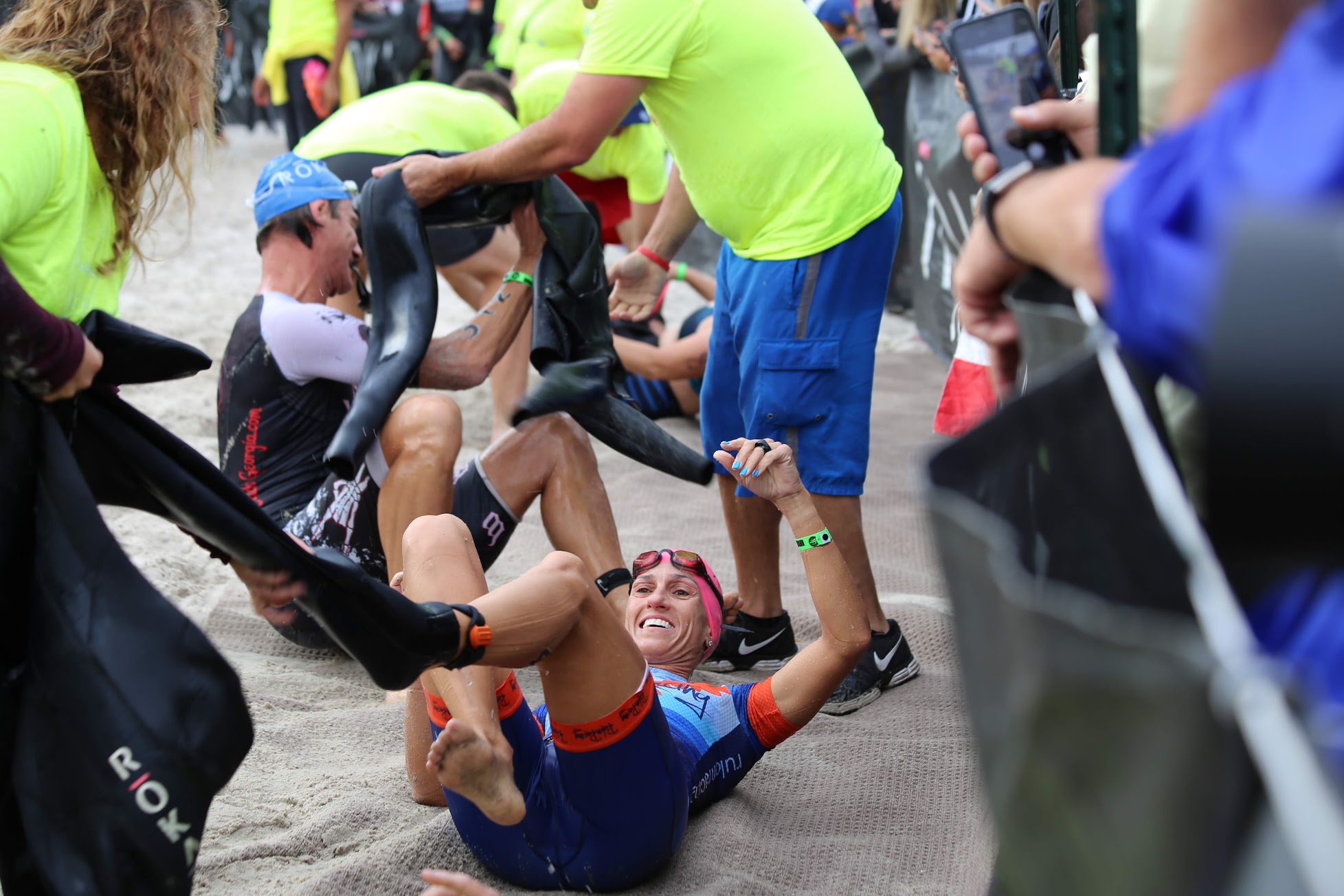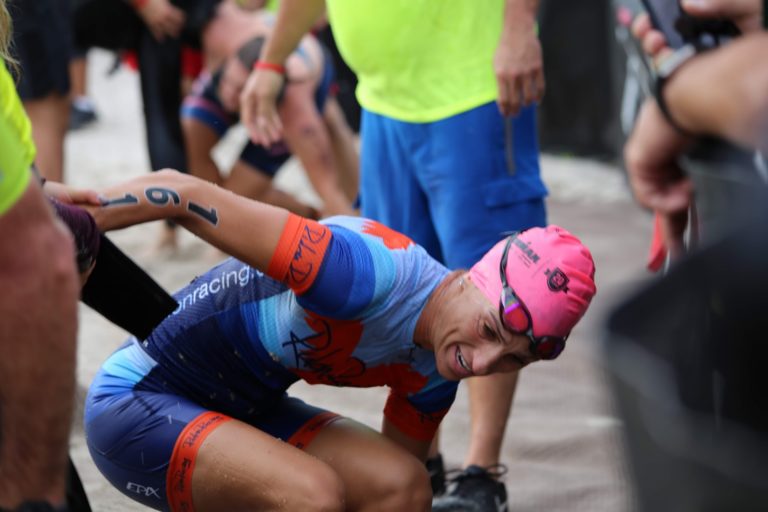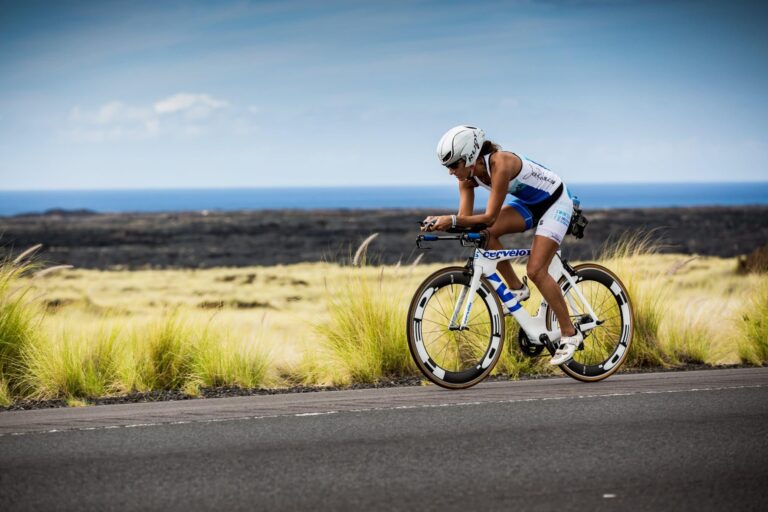
Sidenote from Coach Jen: Transitions in the triathlons can be tricky. Yes, the clock is still ticking. There is a time to take your time (Ironman, as maybe you are changing out of your cycling shorts to running shorts) to get out of transitions as fast as possible, especially for a sprint and an Olympic distance triathlon. I tell all my athletes, don’t be baking a cake there. Get in. Get your SH$% done and go. Here are some thoughts for your race season!
A triathlon is a sport of three events: swim, bike, and run. We also know that there is also the 4th event in triathlons. So let’s break it down.
Transition 1 (T1) is the swim to the bike, and Transition 2 (T2) is the bike to the run. Transitions can be the best place to shave seconds off your race. I feel that it depends on the type of competition you are doing. Doing an Ironman vs. a sprint triathlon is a big difference in your transition times. I have seen some athletes spend 15-30 seconds in a sprint, but I have also seen athletes spend 15 minutes in an Ironman transition. I even received a massage in the T2 at Ironman Wisconsin while putting on my running shoes. Depending on your race depends on what you need for your transitions. But let me give you some quick tips to improve your transition times.
The first part of making transitions easy, fast, and smooth is to get organized. Being organized consists of having the right gear and having it arranged in the order in your transition area. For each race that I do, I have a gear list of what I need for each event, pre racewear/post racewear, and nutrition. Then mark it off when I have it packed and when I get to the sight. Need that list? Click HERE!
You are at the race. It is time to set up your transition area with the following: “Rulon Rules to Transitions!”

I’m not too fond of this part. I like to push it, BUT I am also less stressed when I get there earlier. I can take the time to listen to music, talk to friends, set up transitions and make sure I have figured out where to bike out/bike in is and run out is! I am not a fan of getting up uber early, but the morning ☀️is sweeter! Wear your swimsuit or race gear underneath your clothing because there may not be anywhere to change. An excellent investment is a transition bag, which will help you from your car/hotel to the transition sight. If you are doing an Ironman Triathlon, you won’t be able to take a big bag in transition.
Recently, some races have had the first-come, first-serve bike rack. Hence, see #1. Some athletes prefer the front wheel going right out to the transition area, or others prefer the front wheel and handlebars on the rack. It is totally up to you and how you have practiced it beforehand.
Spread your towel to the left/right of your back wheel or front wheel. You only need a ¼ of your towel. Please don’t spread the whole towel out. Most importantly, set your gear in the order you will use it.
Layout your bike shoes; put the clothes you plan to wear for the bike (if any) on the shoes. Lay your helmet up on your aero bars with the straps out, and put your sunglasses inside your helmet. Ensure you have water or nutrition (that you used in training) in your water bottles, which should be in your bike cage. Freeze your water the night before your race, especially if you are racing in T; it should still be cold during your ride!!
Put your running shoes (if different from your bike shoes) just behind your bike shoes. If you wear a hat, put your race belt in your hat. The race number is made of Tyvek and can flap in the wind, so I suggest you crumble up the race number so it doesn’t flap. But if you are like my athletes and my husband, who can NOT do that. I understand! HA! If you are doing an Olympic and up, you will need some nutrition. With that said, I like to put my nutrition in a ziplock baggie and put that in my hat. Then, when I leave T2, I can grab my hat, start running and put all my stuff on.
For example, walk from your bike rack down to the entrance of T1. Then walk back to your bike and count the number of bike racks to where you racked your bike. Do the same from the entrance back into T2, so you can again find your spot at the end of the bike leg. If you can’t remember these two numbers, find another way to spot your bike out of hundreds or thousands of bikes that will be racked in the transition area. Look around to see if there are any landmarks, trees, etc., that will quickly help you find your bike. Remember, though, the hot pink Cervelo next to yours may not be there once the race starts when you come out of the water. So don’t pick another bike!
One thing that people don’t practice is transitions in their workouts. For example, I may give an athlete who is doing a sprint triathlon on Sunday and have them do this practice on Wednesday, so it is fresh in their head. They can also mentally prepare for the race:
10’ Warm-up bike| 5’ warm run |15’ bike | 10’ run | 15’ bike |10’ run |10 min cooldown of bike or run
This workout may help a sprint athlete work on changing from bike to run shoes or if they want to work on getting out of their bike shoes without clipping out or practice with the shoes already in place on their bike.
I hope you have learned some ideas and some tips about transitions. Once again, practice these transitions, and you can learn to shave off seconds on your overall time. That may help you place 1st or get a spot for Ironman-Hawaii.
Do you have any tips for newbie triathletes getting ready for their sprint triathlon and transitions? Share below!
Check out my STORE for more goodies in the triathlon space!
